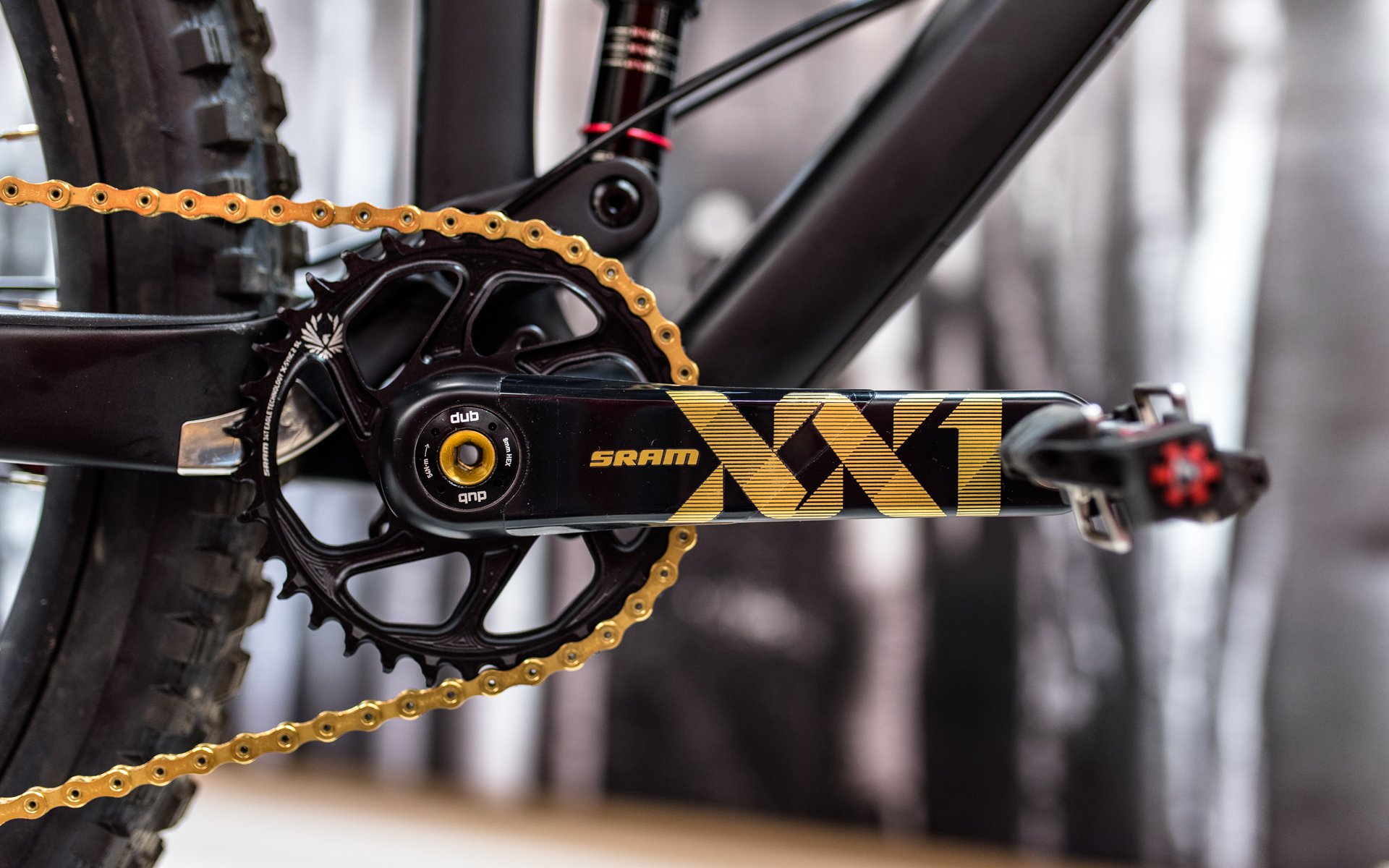
Product Intro
Introducing SRAM DUB Cranks and Bottom Brackets
When we heard SRAM was going to announce something new most of us had guesses and while some of them were even educated, nobody guessed cranks or bottom brackets. Current systems aren't perfect and there are standards issues, but what could be done? SRAM felt a lot could be done so they started from scratch to create a single system that will work with every common BB standard but, they told us, without any durability or sealing compromises. The XX1 version will also take over as the lightest system, dropping almost 100g from SRAM's previous flagship crank and BB.
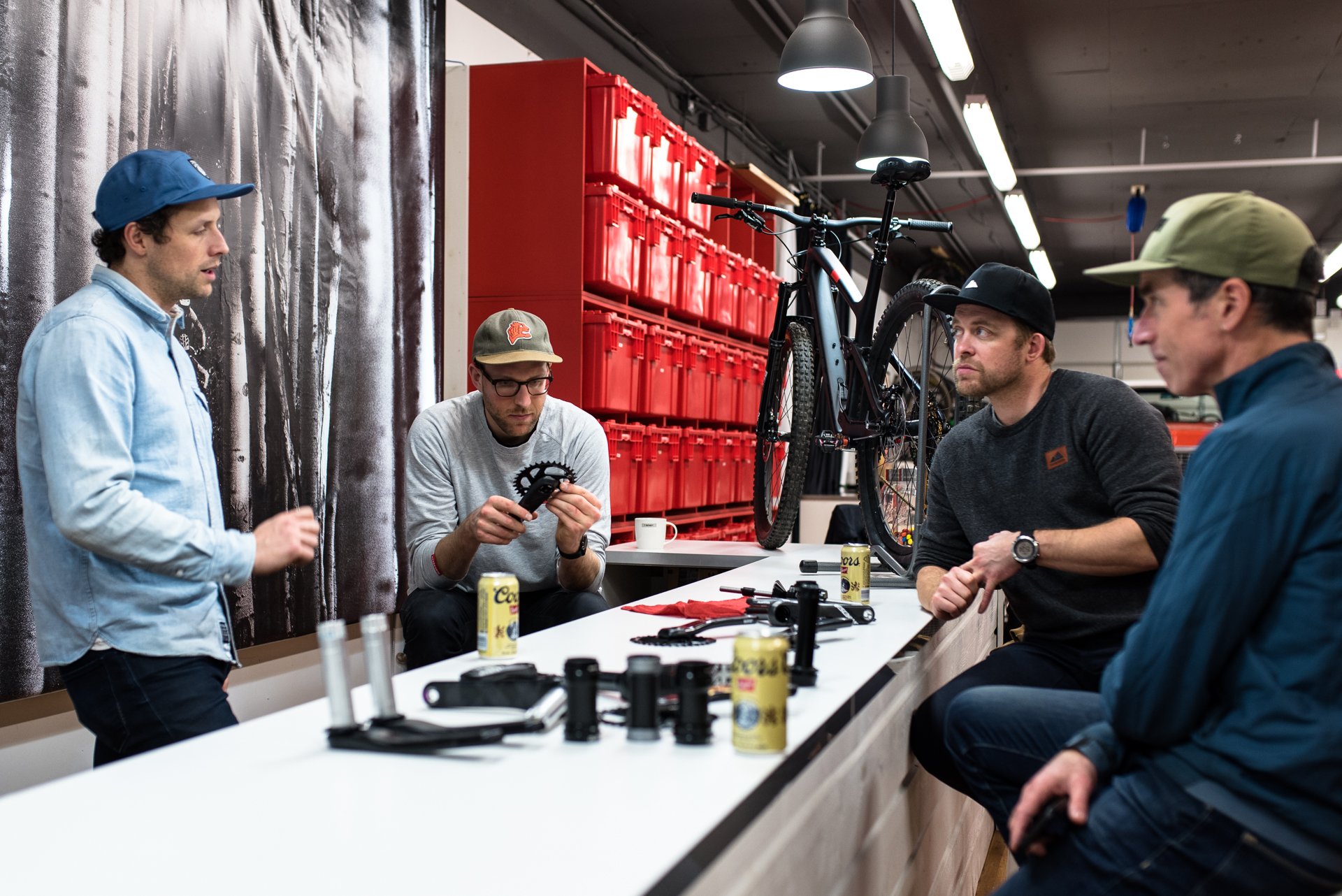
We got the lowdown from Tyler Morland and Ross Measures at SRAM Canada headquarters.
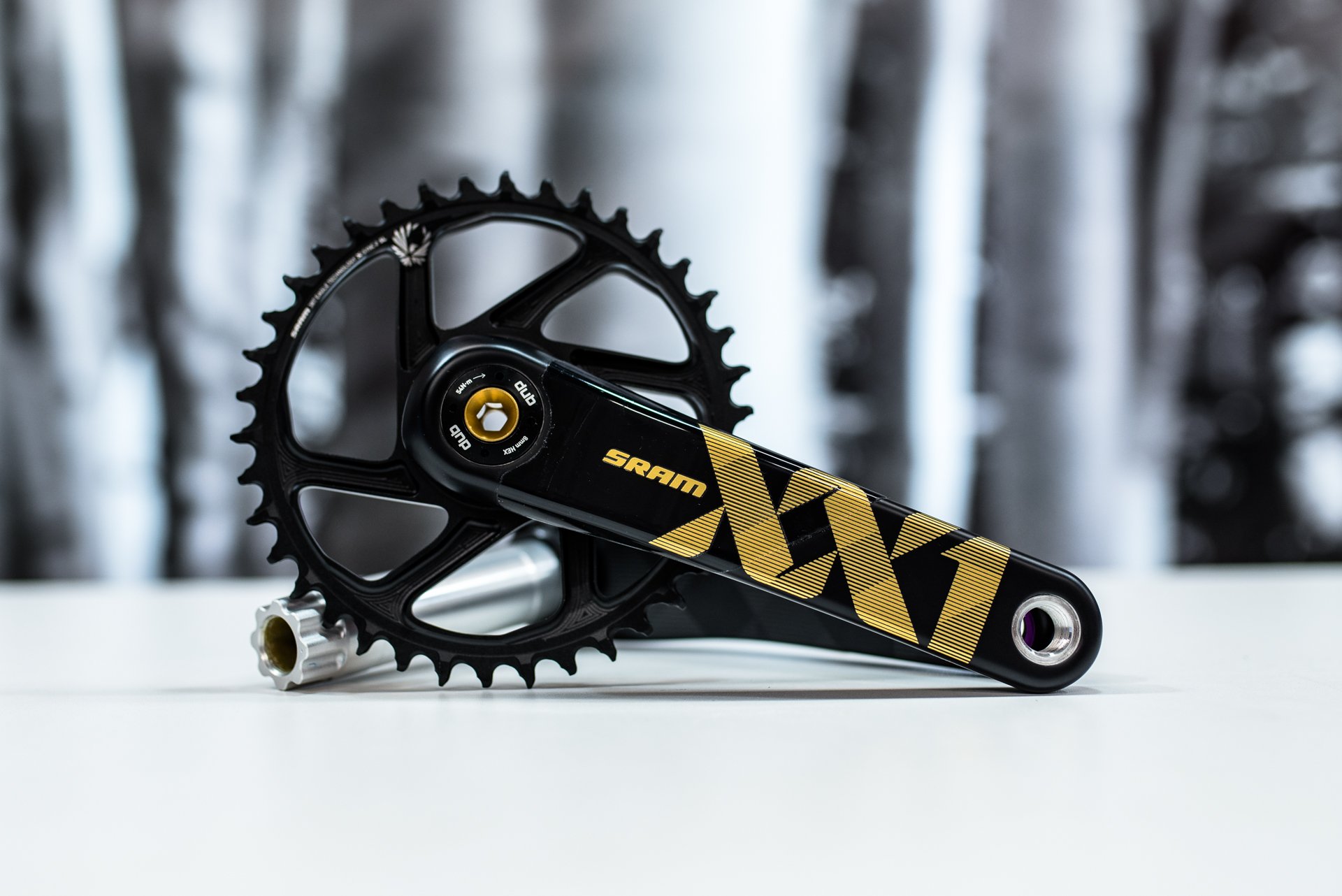
The new lightweight champion crankset - according to SRAM.
My first question was how the engineers and technicians at SRAM's San Luis Obispo development facility managed to deal with durability for a large spindled crank with a PF92 interface that leaves little room for burly bearings. It isn't mentioned in the marketing materials but the spindle is only slightly thinner than the troublesome 30mm spindles that seem to make PF92 bottom brackets prone to premature failure.
The flower pattern is very similar in time and complexity to our current 30mm spindle and crank interface. The general design was based off of that already proven interface, but then we made some geometry updates to the DUB spindle flower pattern in order to provide a more consistent install and removal feel. With the new modified flower pattern we will now have a more consistent feel for install and removal than we did before with our 30mm systems. As for the process itself in manufacturing the pattern, both the spindle flower interface and the crank flower interface are done with precision CNC machining. This certainly takes more time than a typical coined interface, but given the results of the entire system we are happy to spend the extra time to ensure we have a good robust interface. - SRAM

The "Flower" that interfaces with the drive side crank is an intricate bit of machining.
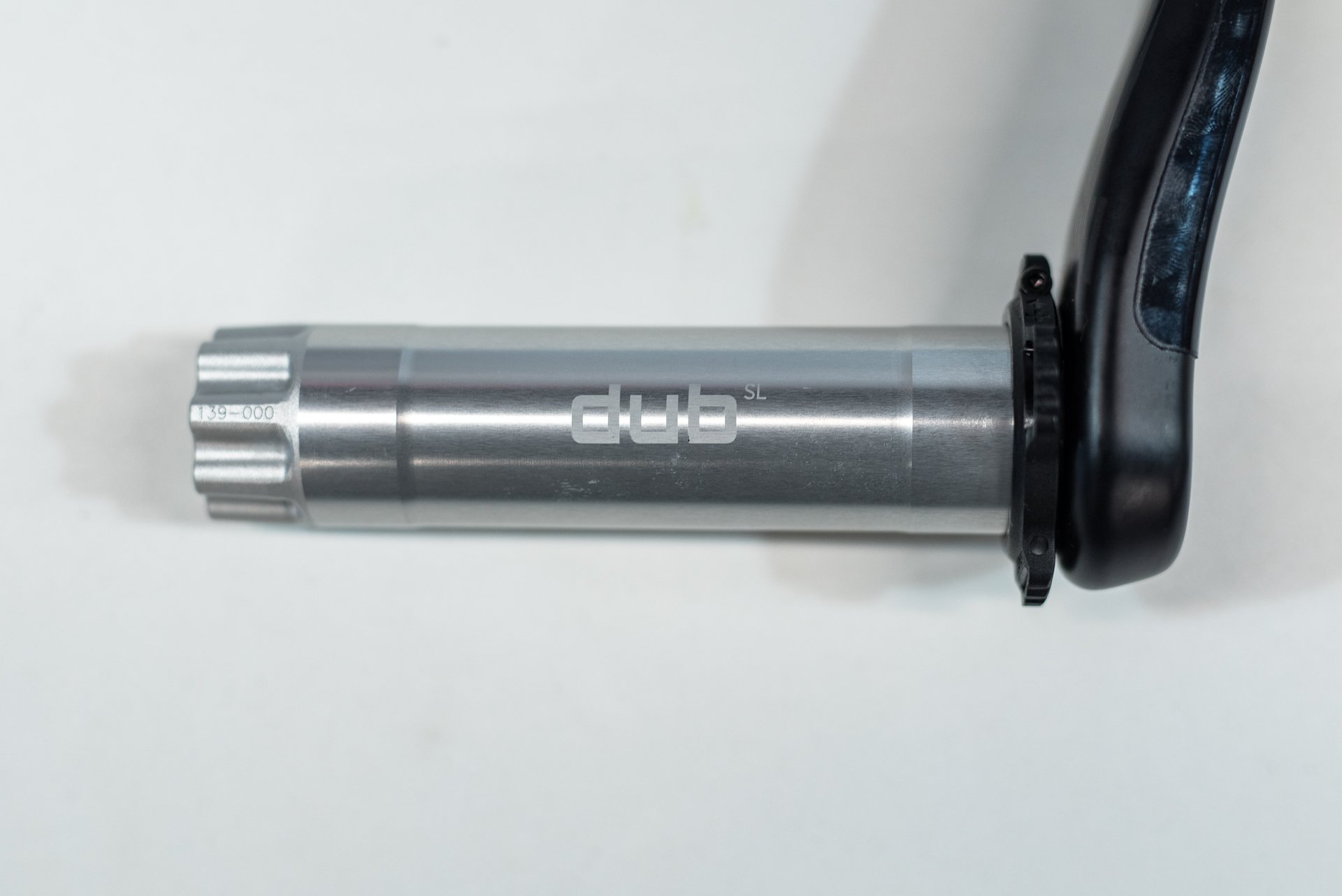
I was initially told the spindle thickness was "between 24 and 30mm" but the SRAM guys in North Van told us it's just shy of 29mm - 28.99 as I recall.
Fat spindles are strong which allows weight to be shaved so middle ground needed to be established. The final diameter ended up being just slightly less than 29mm, but I was told that for an engineer working with these restrictive parameters that's like "a football field." Apparently, the thickness of a dime was enough to allow SRAM to create bearings that are well sealed and durable. The quote below details what SRAM told us about the testing procedure.
As for durability data from the BB side of things. the spindle diameter was just a result of us reducing the size enough to get the sealing we wanted. Sure 1mm might not sound like a lot, but in seal design language 1mm is a big deal. Same way people at first thought +3mm of clearance with Boost148 frames couldn’t make that big a difference. Turns out for a frame designer, 3mm is HUGE and you have seen the awesome new bikes they have come up with since the introduction of that platform. So there will certainly be skeptics like there are with all designs, but the proof is in the results. In all of our lab testing, when compared to the same conditions as our other BBs, the DUB bottom brackets have outperformed our previously most durable bottom bracket (GXP threaded). And the DUB BBs do so in every configuration we offer, not just the one that is compatible with Threaded BSA frame shell standards. - SRAM
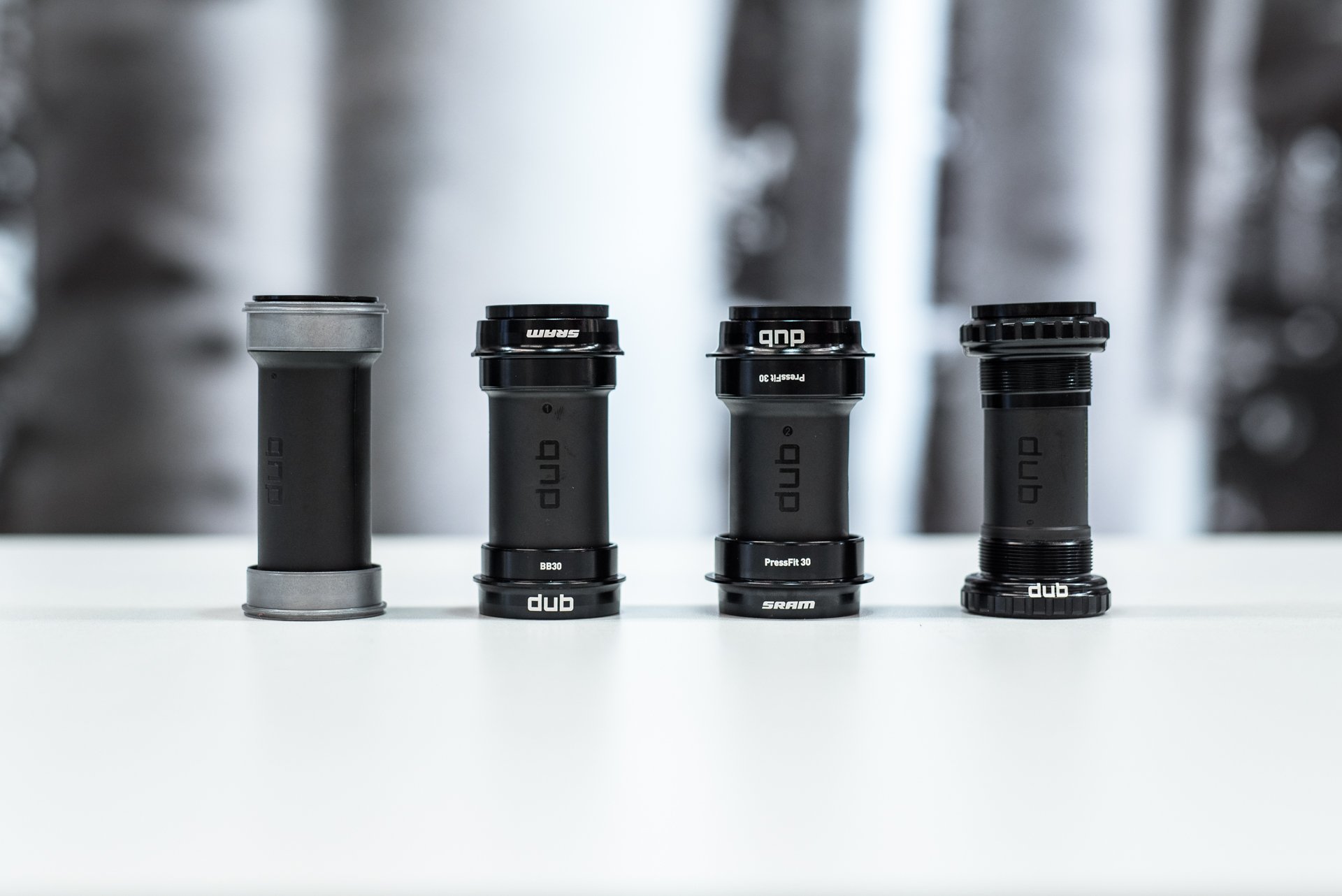
Four bottom brackets with identical bearing placement. This sort of consistency makes product managers happy.

Making a durable PF92 bottom bracket is the holy grail. All of SRAM's DUB BBs have aluminum cups except the PF92 which is steel. Finally, plastic cups will be banished.
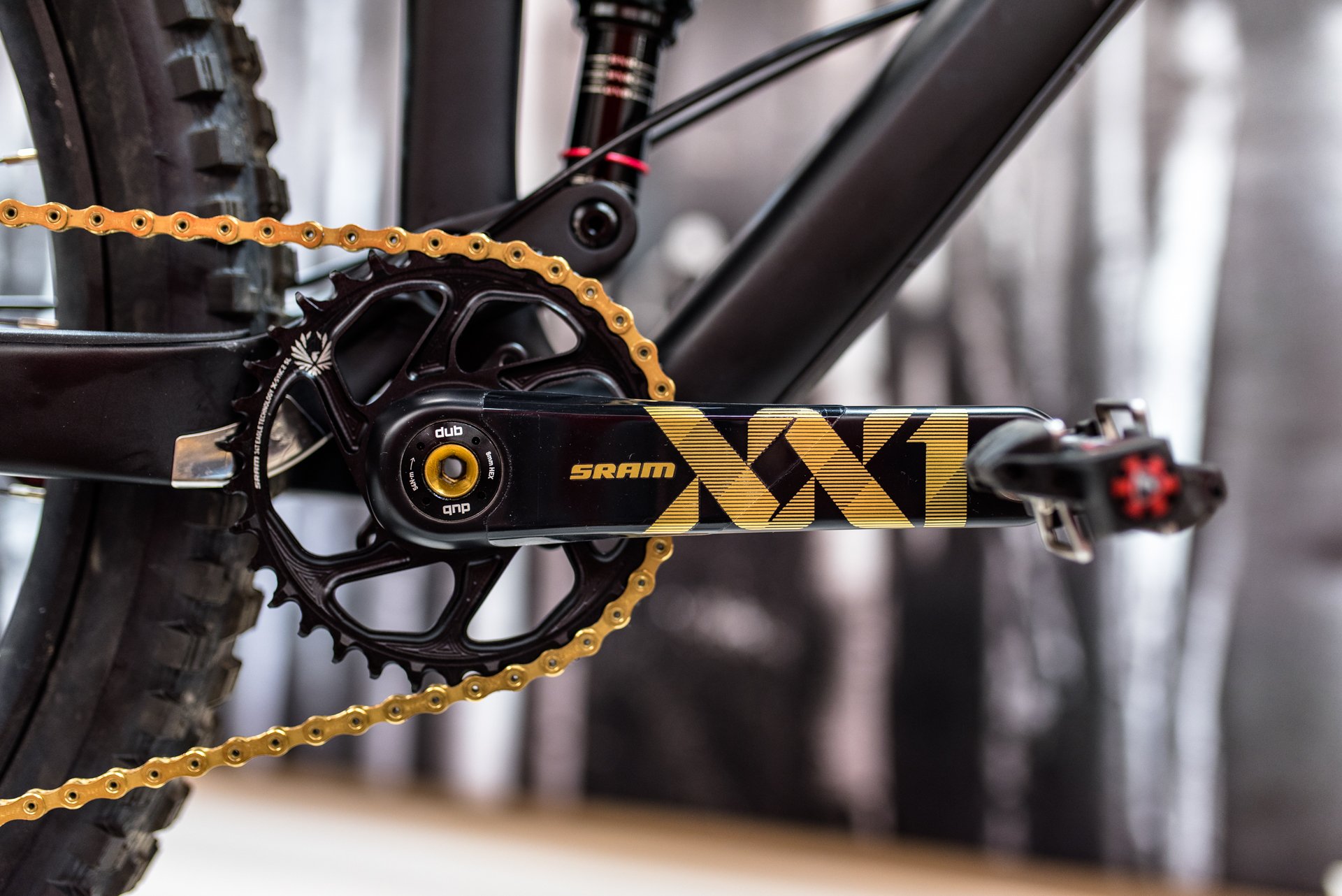
Mounted. XX1 cranks will be available in the original gold...
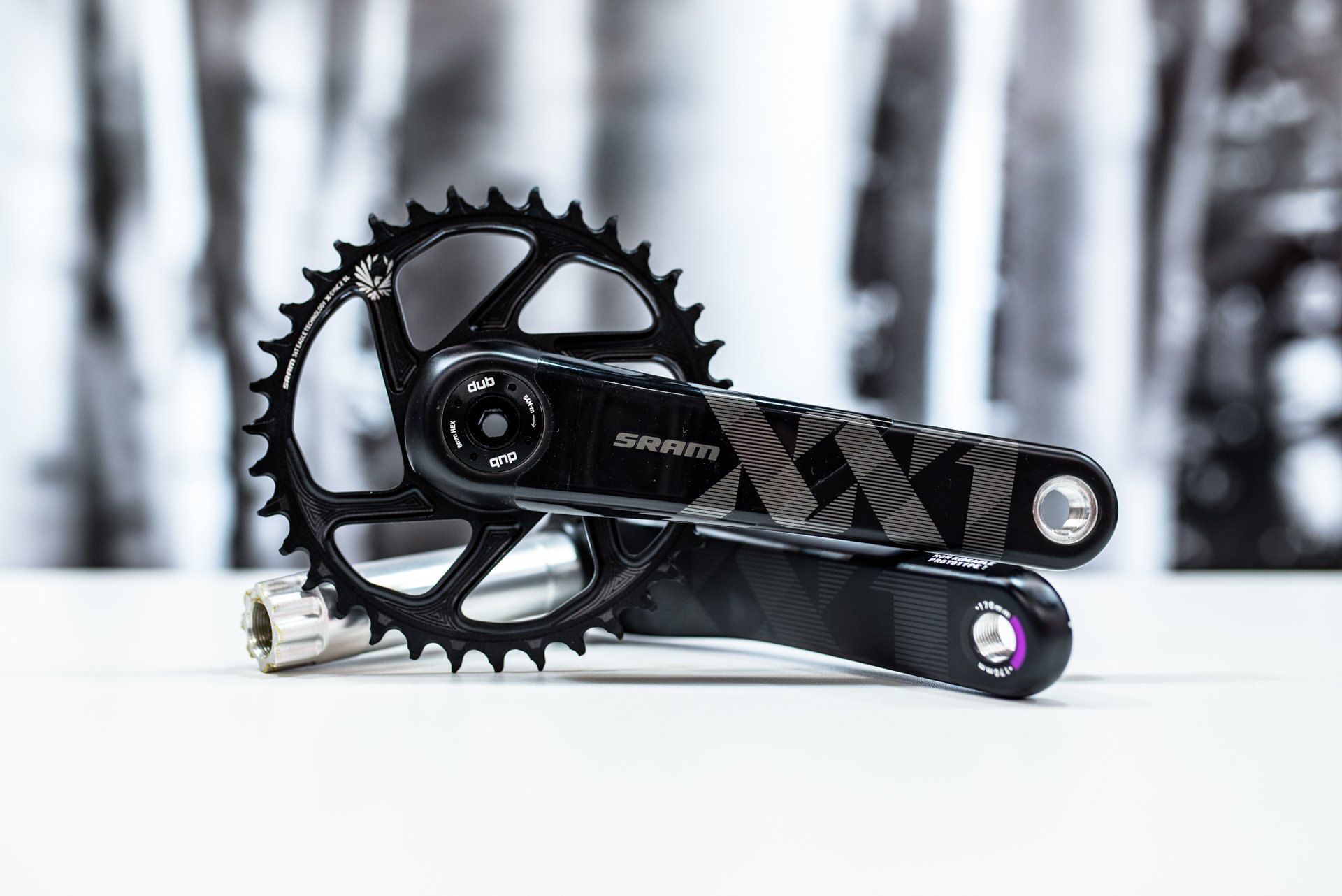
...or more subtle monochromatic tones.
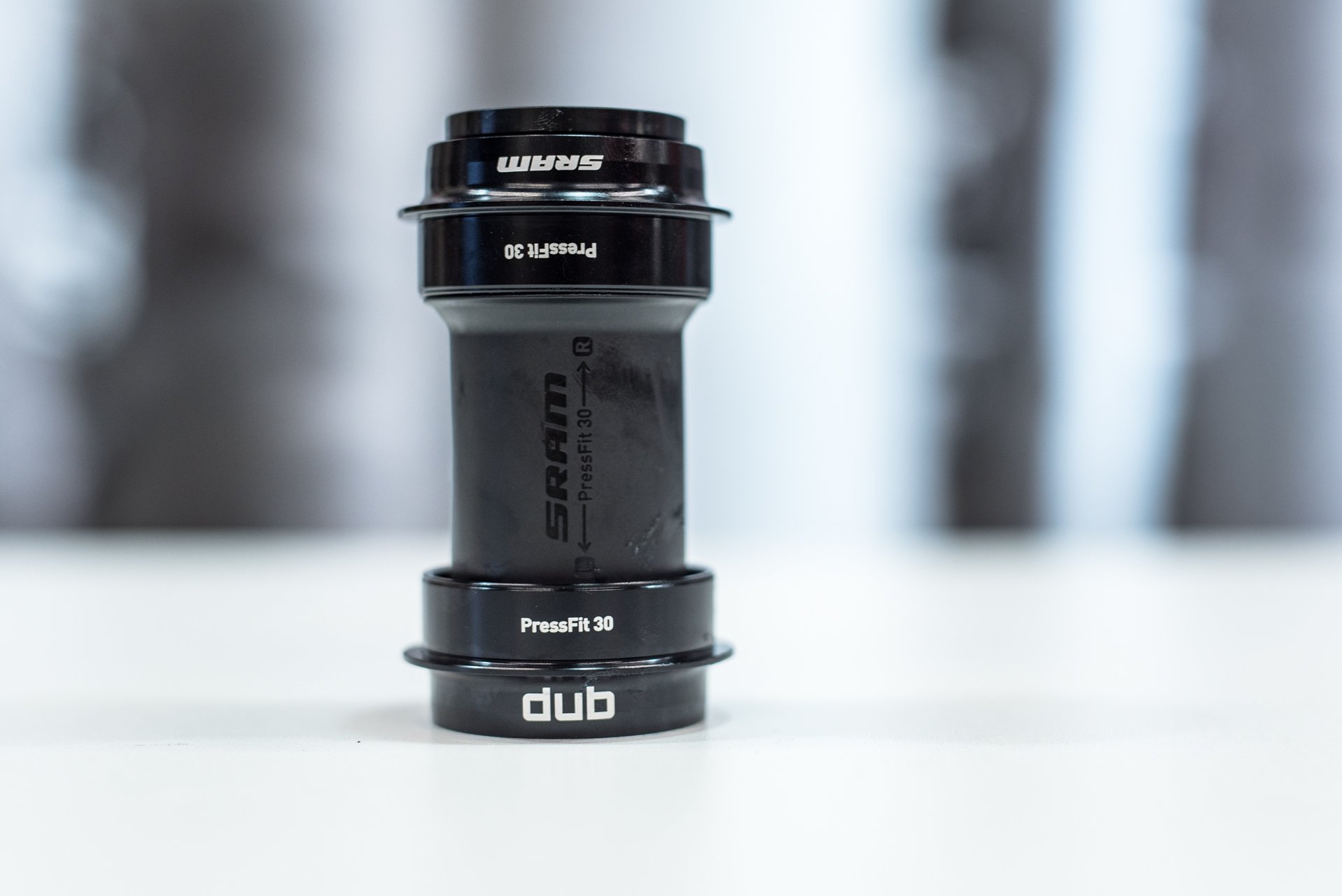
The Pressfit 30 bottom bracket features outboard bearings.
One of the signature accomplishments of the DUB system is producing what SRAM is calling "the world's all-time lightest crankset." The XX1 with 175mm arms, spindle and a 32 tooth ring weighs 422g according to SRAM. Add a PF92 BB at 71g and you are at 493g complete. Apparently most riders will be better served by the XO1 chainring because the XX1 has taken machining to the wall but otherwise this set up is durable enough for most riders.
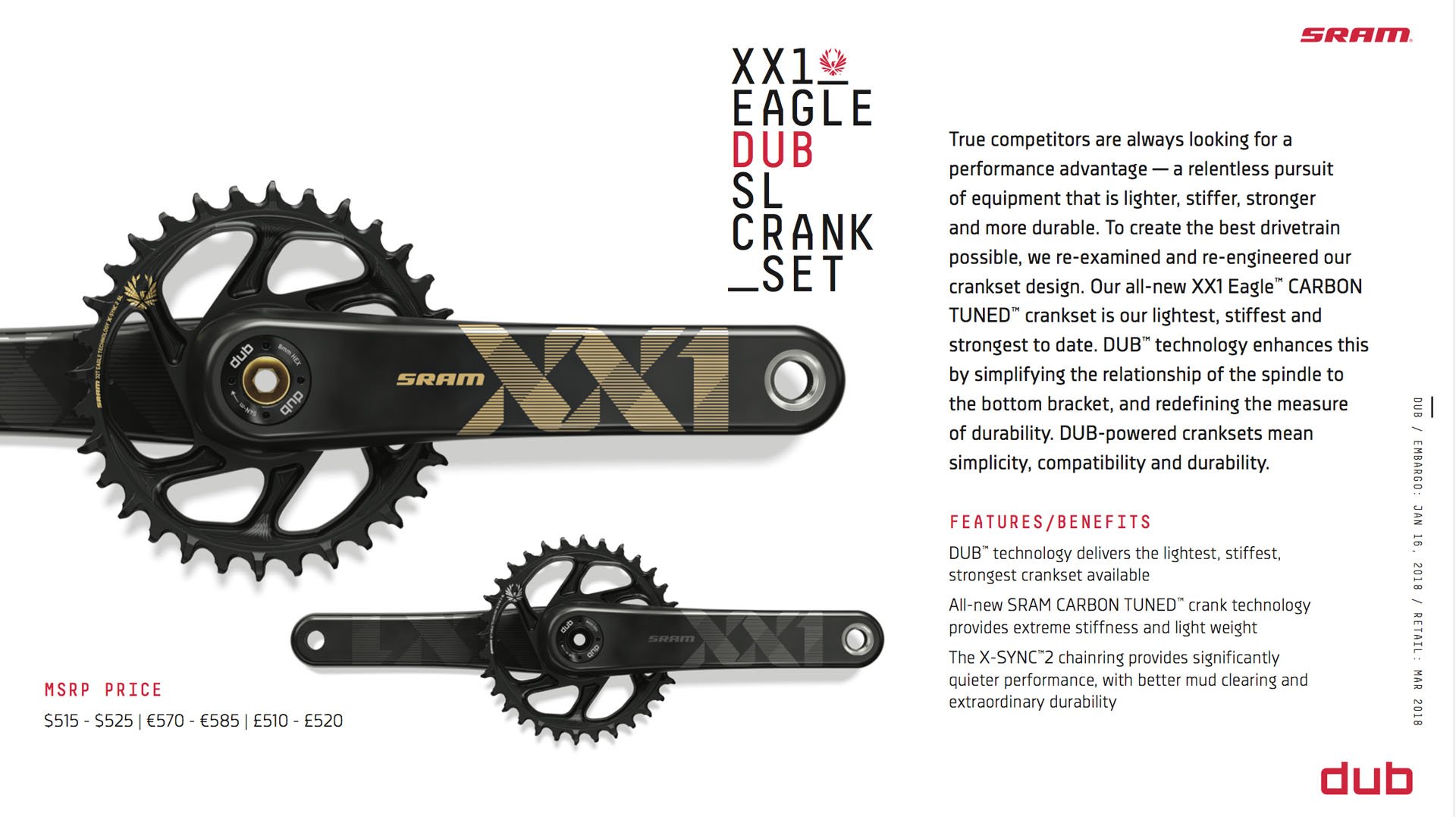
Click to scroll right for every DUB crank model.
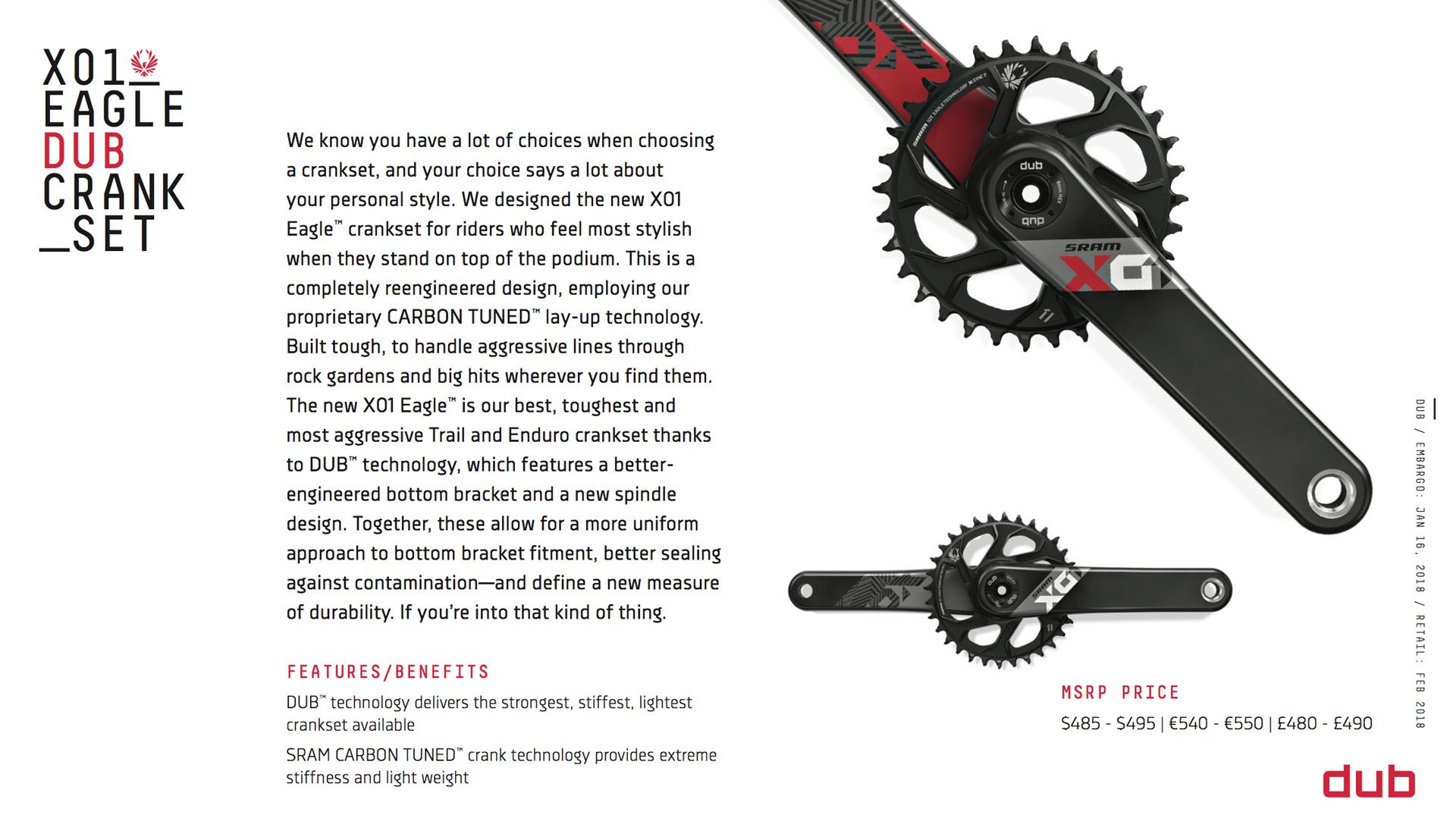
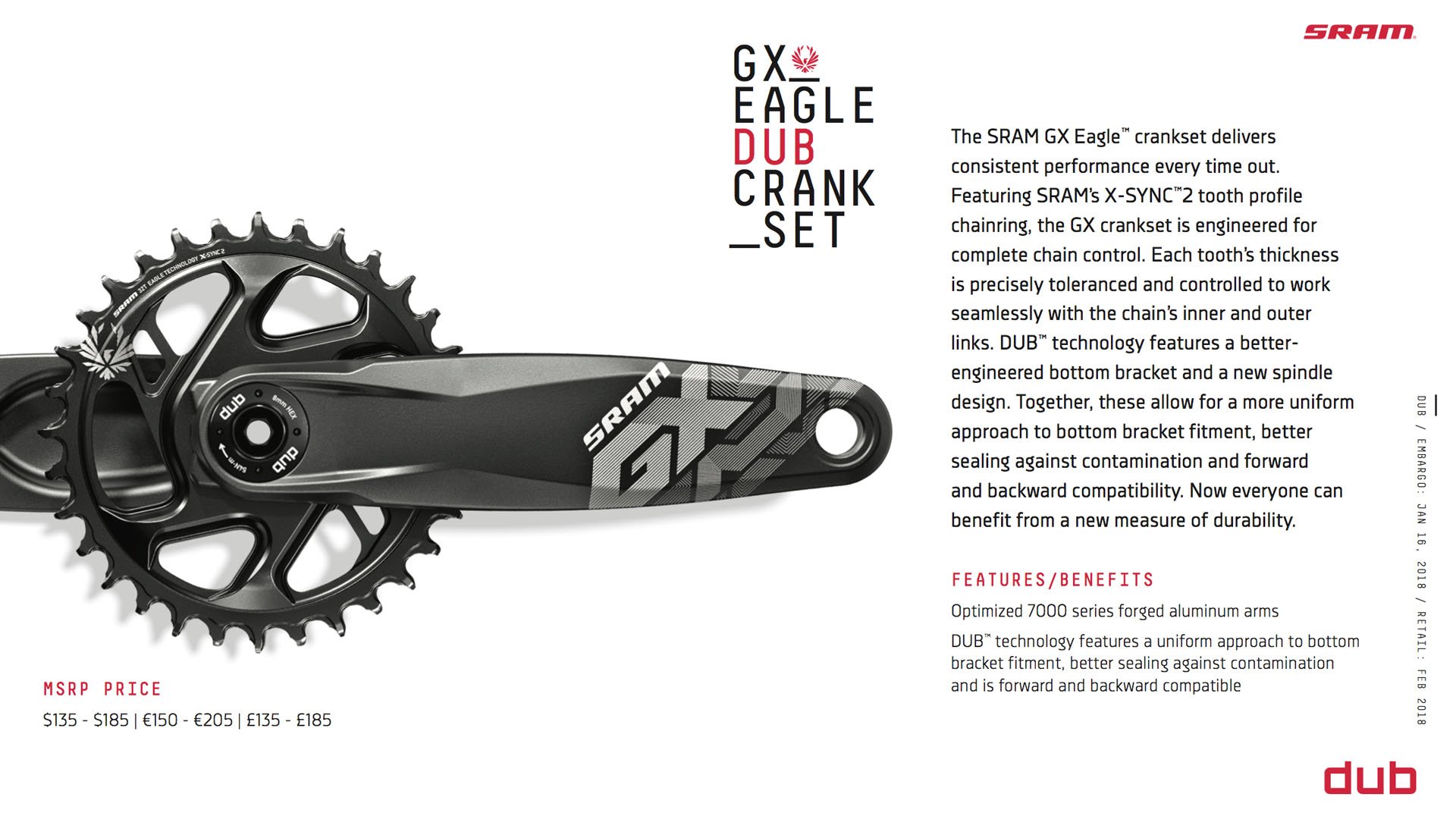
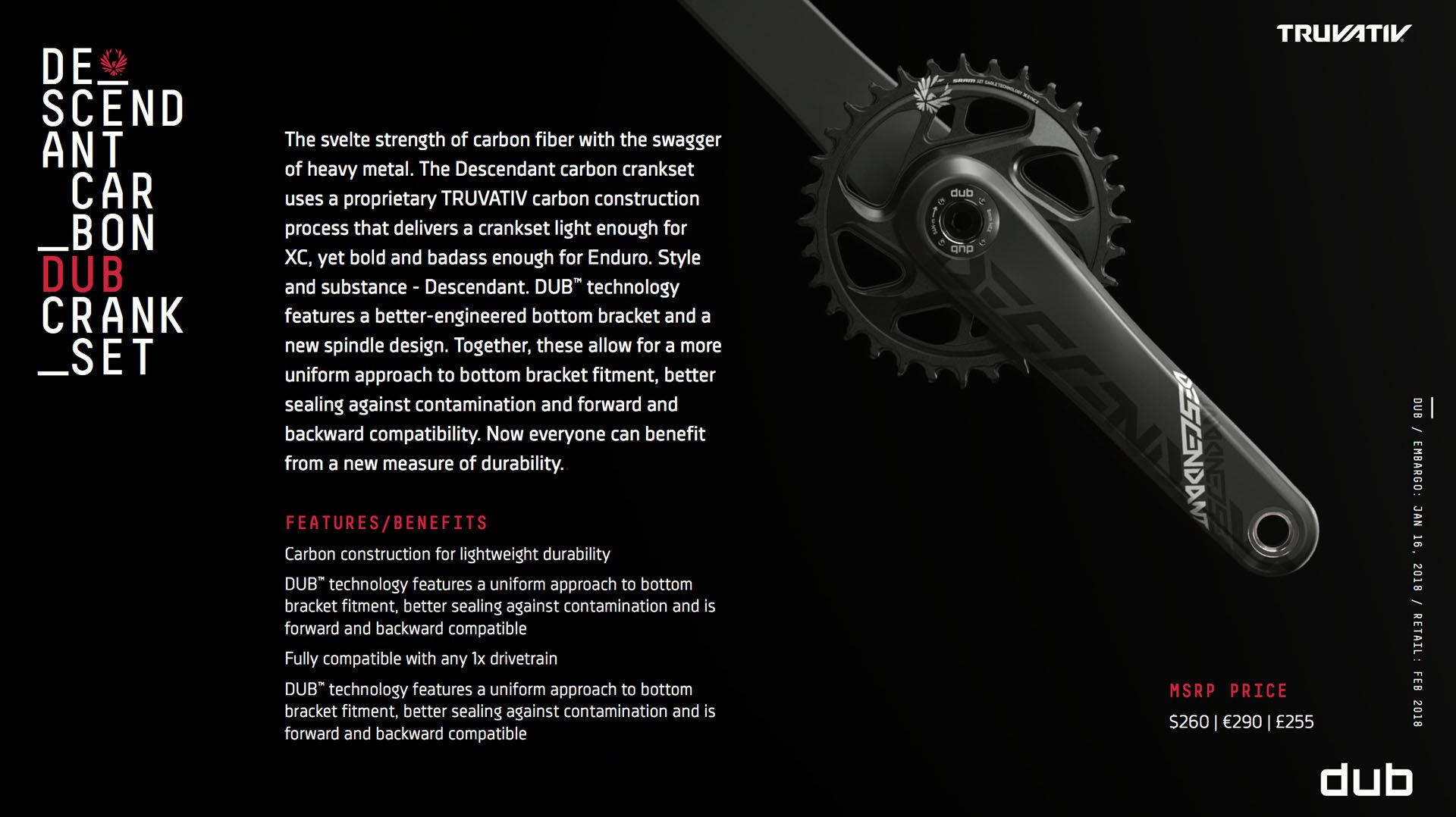
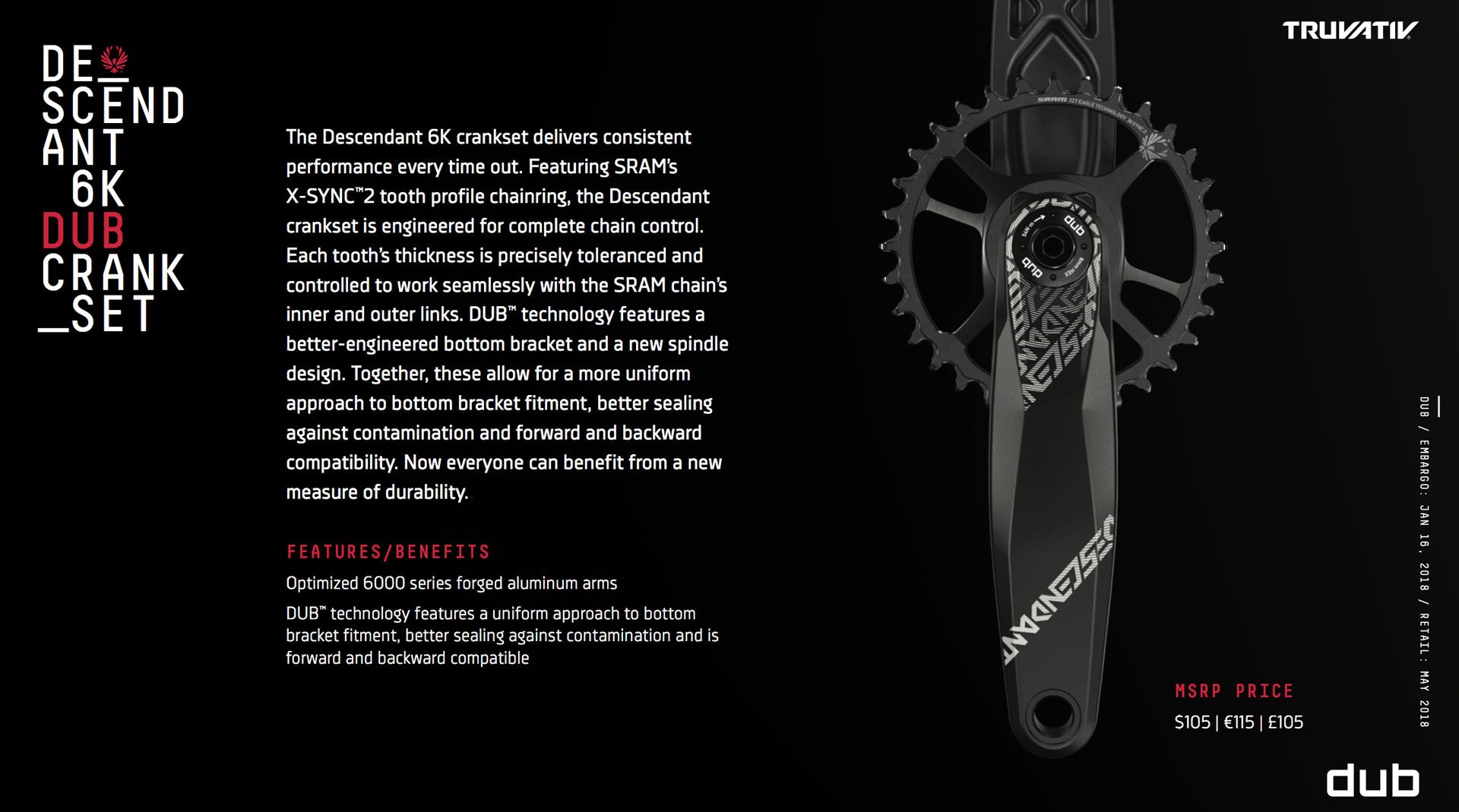
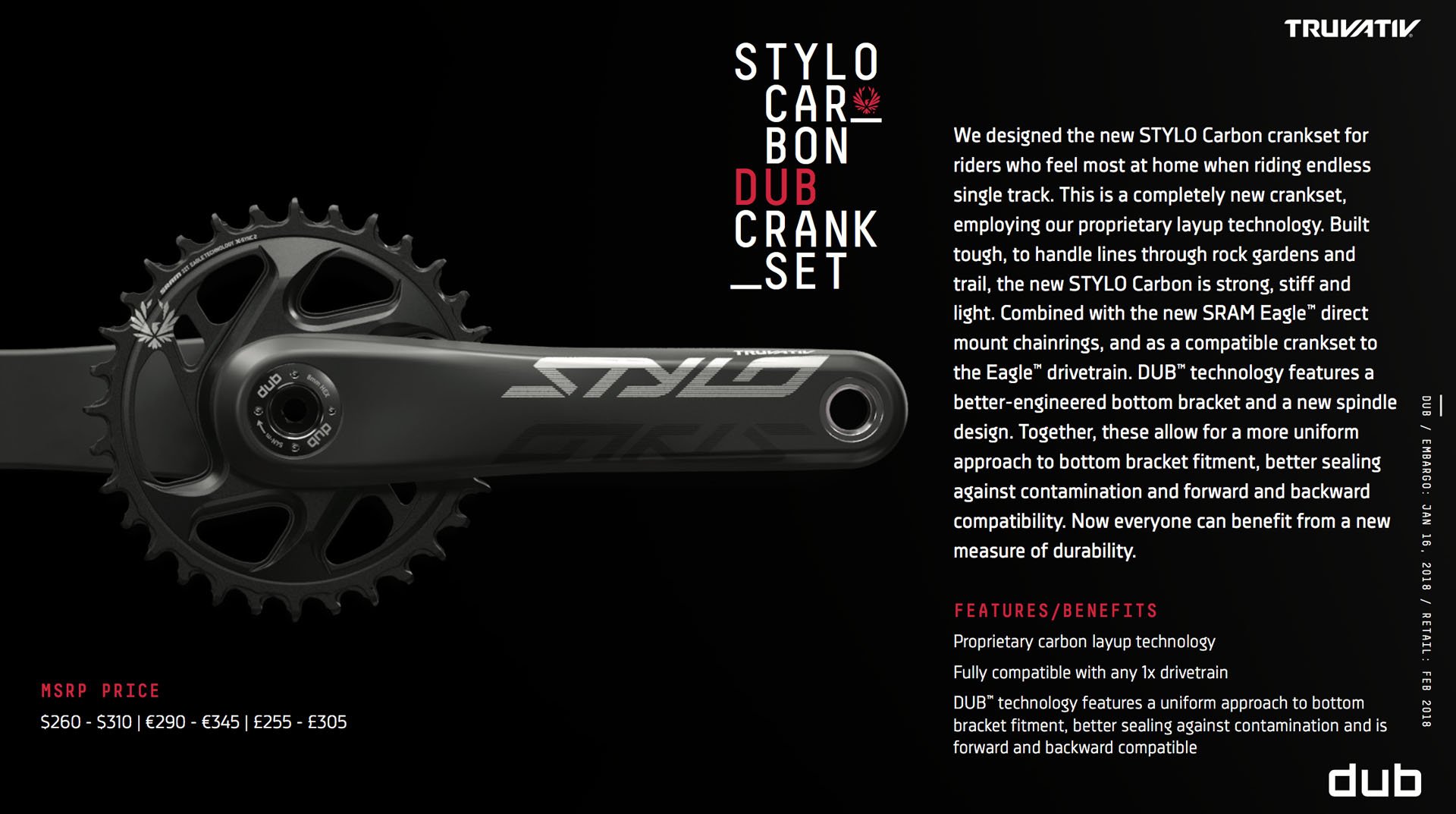
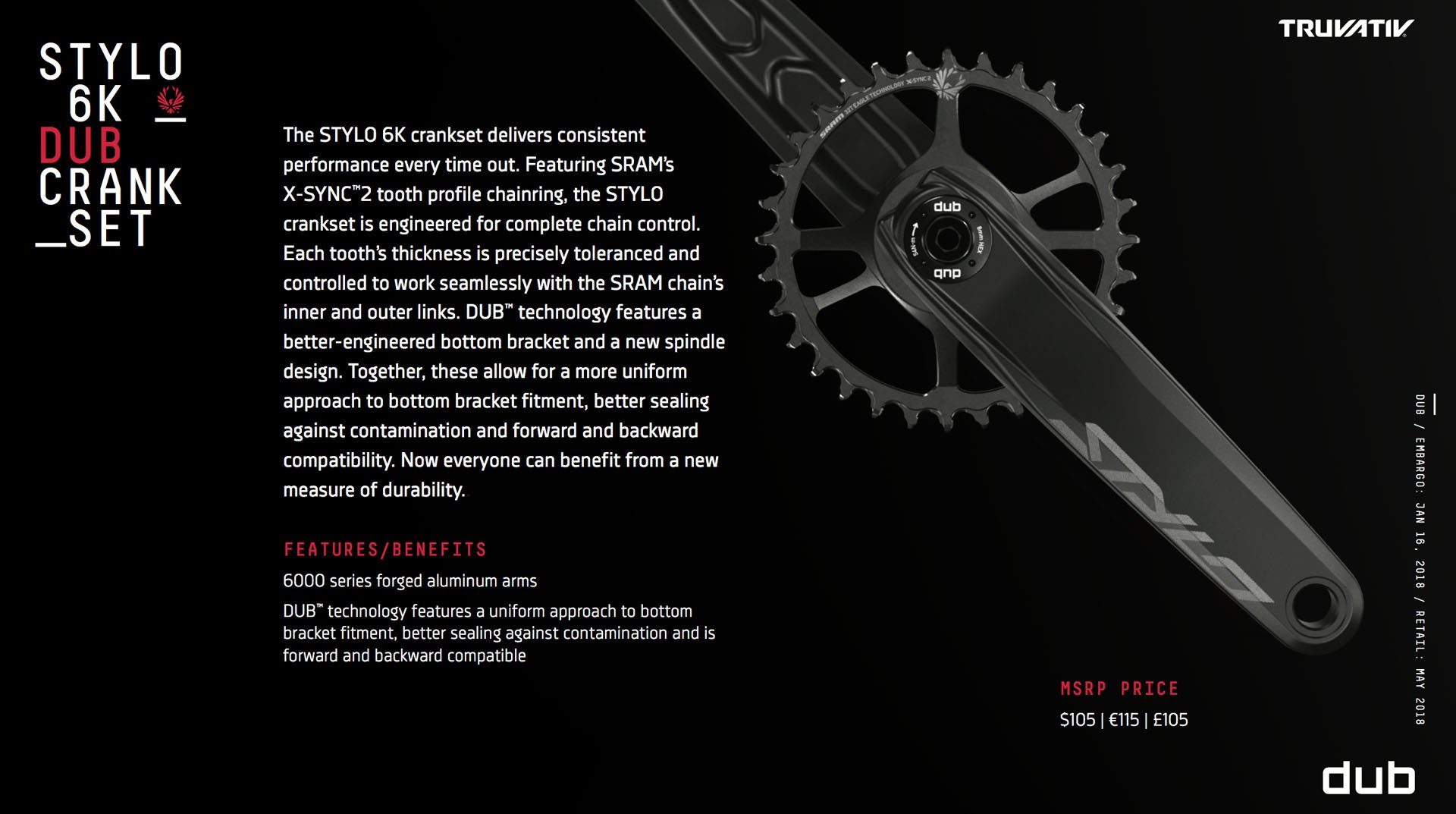
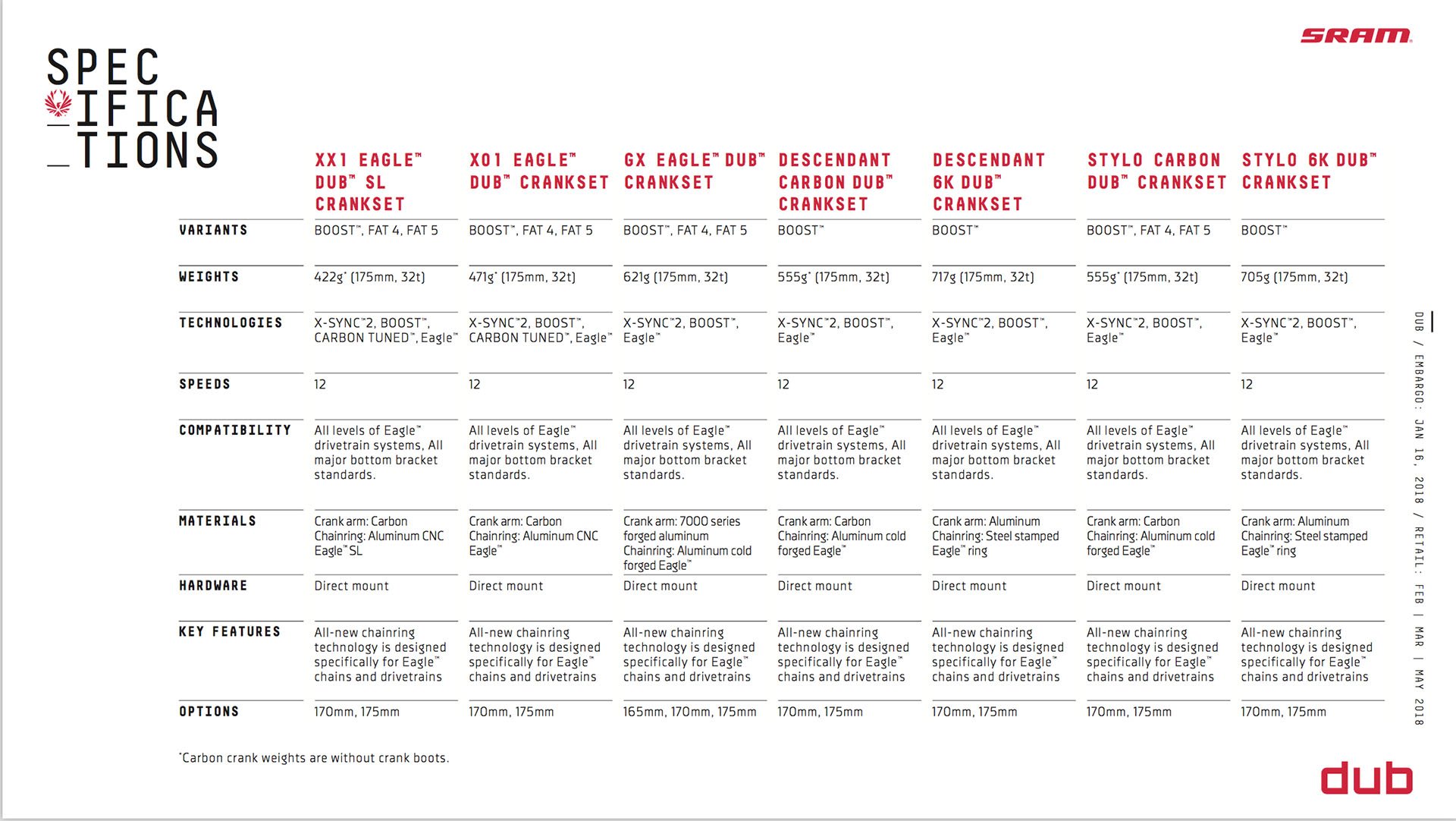
Full DUB crank specifications.
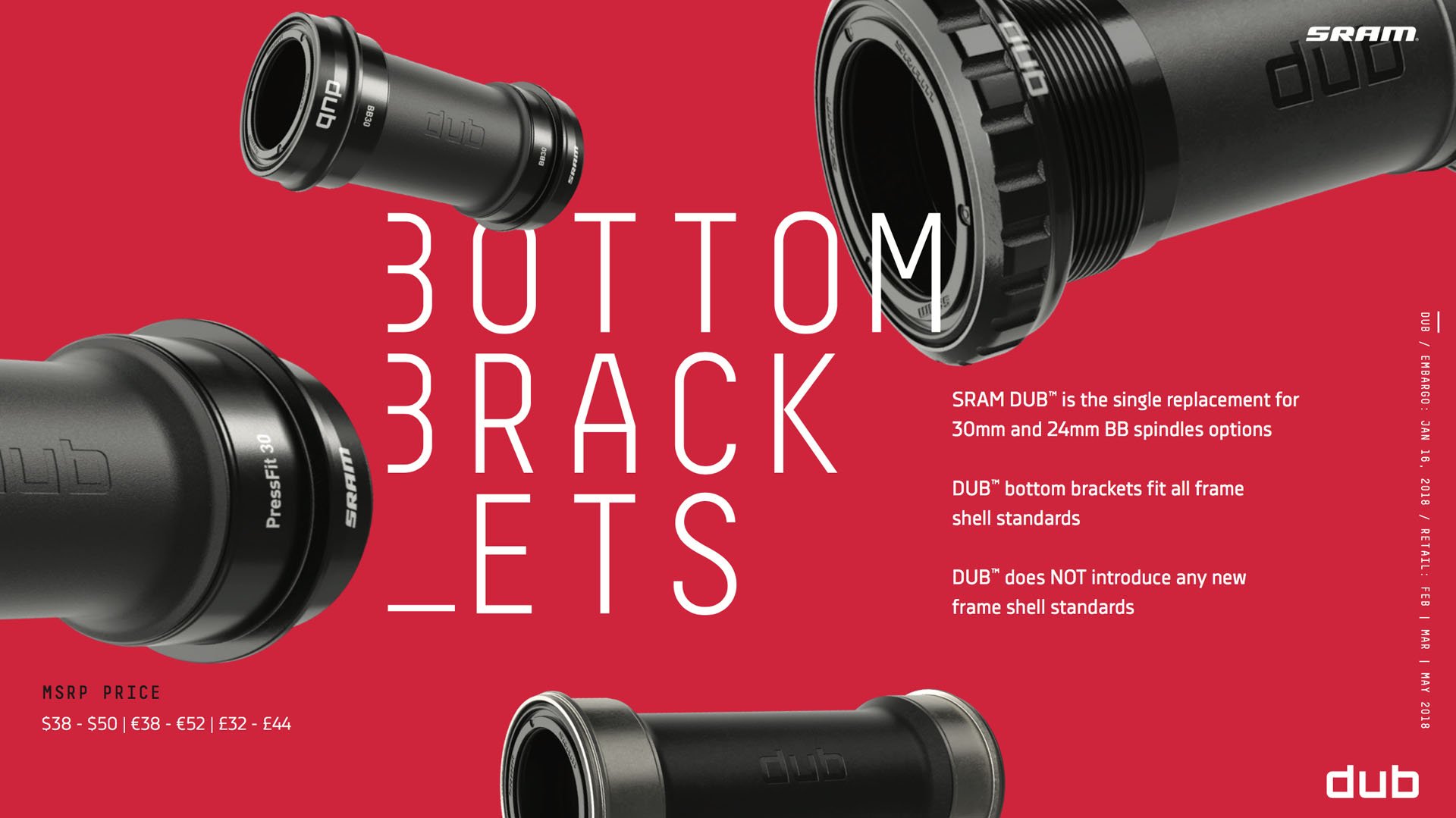
Scroll for BB specifications.
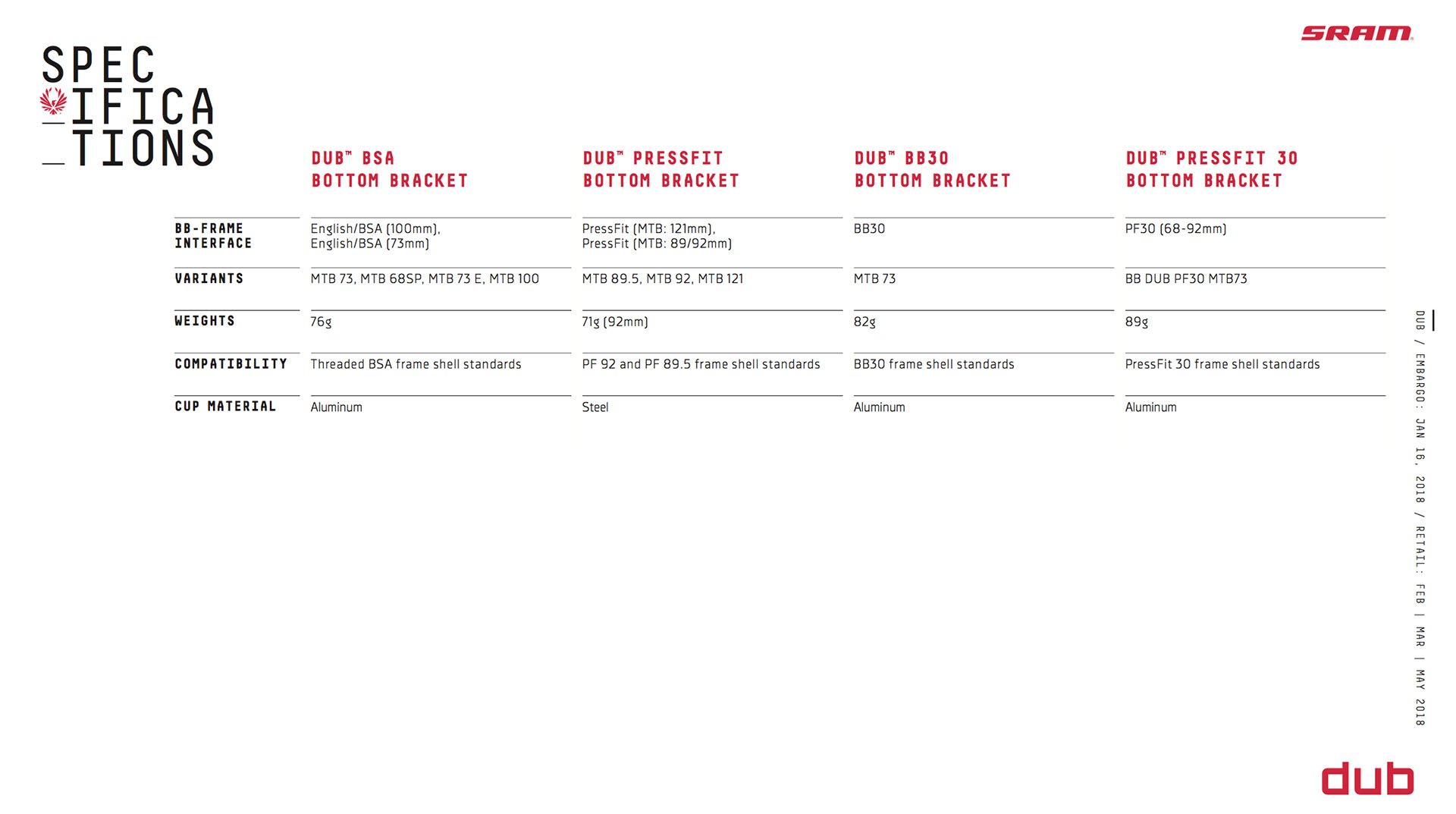
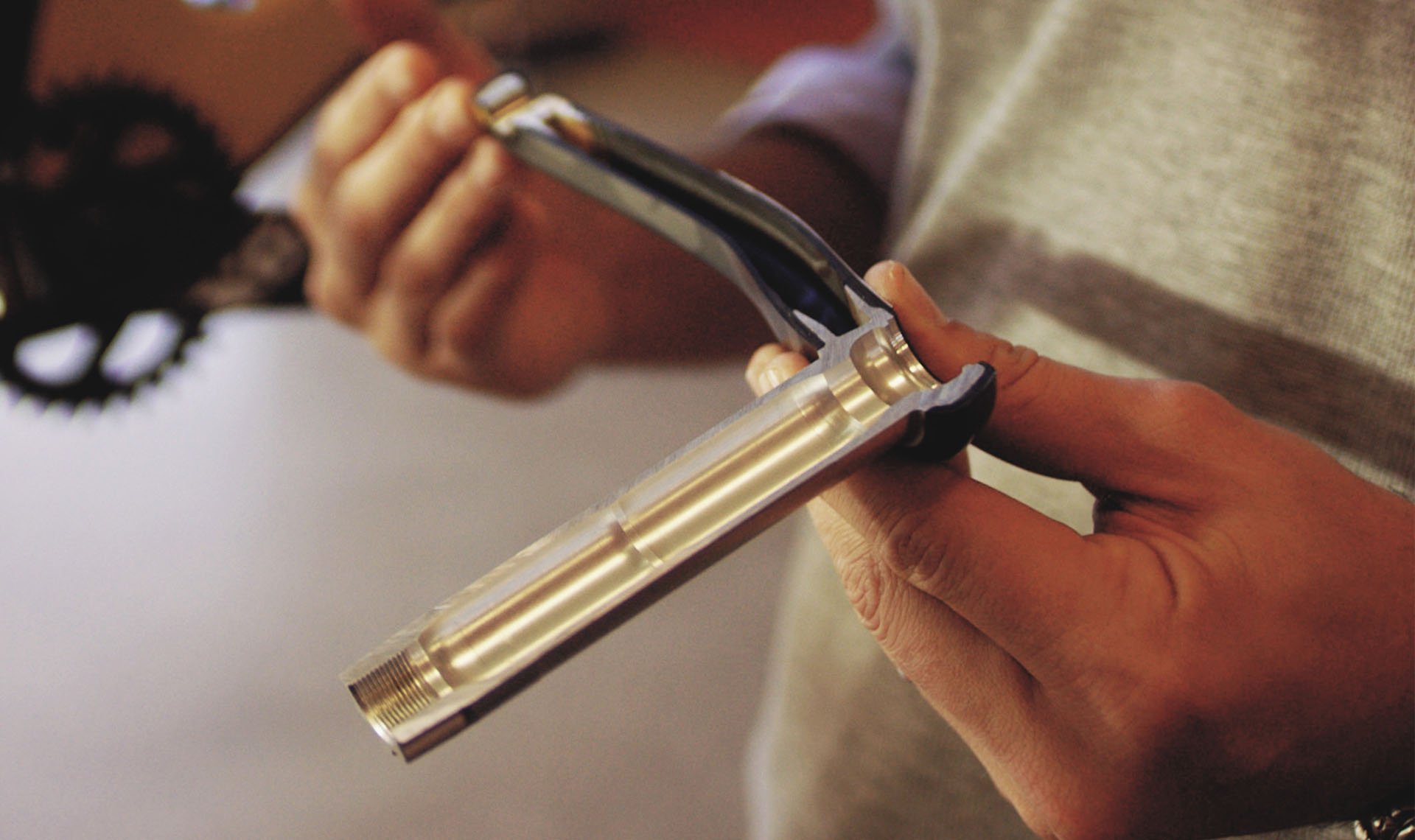
The spindle turns the corner and extends up the non-drive crank arm for added strength. Photo - SRAM

Testing near the SRAM facility in SLO (San Luis Obispo). Photo - Adrian Marcoux
Cranks are one of the components I sometimes keep when it's time to sell a bike, but in the past standards have often made that impractical. If DUB lives up to the durability claims it'll be possible to hang on to cranks before you've even chosen your next bike. While this system is particularly attractive for original equipment spec, it also has the potential to simplify the mountain bike's nether regions for consumers looking to upgrade in the aftermarket. Pricing will be on par with what you can expect for current SRAM products and tiers.
Look for DUB at your LBS in March and on 2018 bike models shortly.







Comments
Mbcracken
6 years, 3 months ago
I'm looking forward to the dentists dumping XTR cranks for cheap... ;-)
Cheers,
Mike
Reply
tashi
6 years, 3 months ago
THIS. I really appreciate all the early adopters out there.
Too bad all the last few years of XTR (most of them I guess) have proprietary BCD’s.
Reply
badIuck
6 years, 3 months ago
It became so cool to hate the new stuff big companies release that no one notices anymore when they release something potentially really good. Instead everyone just jumps onto the hate bandwagon.
Reply
Cam McRae
6 years, 3 months ago
Yep. But I guess it's an inevitable consequence of the silliness that has occurred making everyone bitter. How is a bottom bracket and crank combo that will fit in virtually all existing frames a new standard? Nobody called it a new standard when 30mm spindles came out, but new shell sizes would absolutely be a new standard.
Reply
Shoreboy
6 years, 3 months ago
It is its own standard, as it is a proprietary system. Sure it will fit onto any current frame, but the shops will love having to carry/source 4 more bottom brackets when someone with DUB cranks comes in looking for one.
Reply
Cam McRae
6 years, 3 months ago
Good point. It would be interesting to see if shops are happy about this or not. Currently SRAM doesn't seem to have a PF92 solution listed on the website for existing frames so that's a step in the right direction. It would be good to have a mechanic comment on this. How many bottom brackets do shops currently have to carry? How often do they fail to have a solution for a customer? Obviously this is shop-dependent but I bet even large well-stocked shops have issues.
Reply
Rob Gretchen
6 years, 3 months ago
As a shop owner I can vouch for carrying a dizzying array of BBs, some just to anticipate demand for a problem that may occur. I actually like SRAMs concept although I can see why it would cause some controversy. We do see a LOT of premature bearing failures on PF BBs for 30mm spindle cranks BTW.
Reply
Cooper Quinn
6 years, 3 months ago
Agree. And to copy/paste from FB discussion with Cam:
[walks into LBS]
"Hi, I need to replace my BB."
"Oh sorry, we don't have any that are DUB sized."
If that isn't a new standard, I don't know what is.
Reply
Cam McRae
6 years, 3 months ago
It's a proprietary system that requires no new frame standards. There are currently multiple spindle sizes on the market and they don't all play nicely together - not all 24mm spindles are alike and there are also 30mm spindles (that don't work acceptably with PF92 BBs) and smaller ones going backwards. There are multiple sizes already so there is no standard BB spindle size. For something to be a 'new standard' doesn't it need to be replacing something that has a standard - like 135mm axles or 1 1/8 straight steerers?
I'd argue that bars/stem are slightly different because stems don't need to be replaced generally so you wouldn't replace your stem every time you replace your bar while you would almost certainly replace your BB if you are replacing your cranks.
Reply
Cooper Quinn
6 years, 3 months ago
Yes. It requires no new FRAME (or, what we're really talking about it bottom bracket shell) standards. If you add that qualifier to all instances above, I agree. But standards cover more than frames?!?
Standards cover bar/stem interfaces. Standards cover shifter housing sizes. Standards cover freehub dimensions and interfaces.
An incomplete list current Bottom Bracket shell standards I'm aware of:
Conventional threaded
BB90/BB95
PF86/92
BB30
BB30A
PF30
BBright
BB386 EVO
T47 (which is kind of a funny one, but I'm counting it as separate.)
and now, DUB
Some of the above bottom bracket shell standards were built around 30mm spindles (ok, if we want to really split hairs, they likely started with a standard bearing size conveniently one standard size up from what they were using for 24mm, not a spindle ), but can accept 24mm with adapters. But to counter-act the convenience of adapters, many of frames come in different shell widths for various reasons, and end up needing different SKUs. Conventional threaded is even worse; there's probably 10 or more spindle sizes, shell widths, and crank interfaces.
To one of your points above, 30mm was absolutely a new standard - it was a new, now common, spindle size. A 30mm spindle now should still fit the standard dimensions and specifications set out in the original technical specs.
Sure some of the above BB shells are kind of irrelevant, were short lived, and/or combination-hybrid systems, but then pile on the extra widths, a few spindle diameters, and the need to stock parts, replacement bearings, etc, at various pricepoints, and I'd be surprised to find a shop that's super stoked to carry 4 more bottom brackets to overcome one (PF92) shortcoming?
Is it actually proprietary? I only see that word in the comments. Because that's even worse, and will mean shops will have to carry the SRAM BBs specifically, instead of most of the above listed standards which have multiple manufacturers.
Do shops have to carry additional SKUs? If yes, its not actually backwards compatible.
And just because a standard wasn't long-lived or common doesn't mean it wasn't a standard - it just wasn't long lived. Or common.
Honest question: if you're talking FRAME standards, Boost front axles aren't a new standard. Do you consider 110mm front axles a new standard?
Cam McRae
6 years, 3 months ago
How are 110mm axles (I assume you mean 110 x 115) anything like this Cooper? Before 15mm there were two sizes and they were meant for different things entirely - certainly a standard. Then there was 15mm which was new indeed and meant for nothing actually. And a new standard for which there was no justification. It may have been weaker than 20mm but at least it was heavier. Boost front axles at least had a weak justification, but it was certainly a new standard because there was a standard it was replacing rather than the all over the shop scenario you describe below for BBs. And the bottom brackets you list don't all accept the same spindle diameter. Some accept both 30 and 24, some accept one or the other, while some accept some 24mm spindles but not others. Dub is BB30, PF30, PF86/92 and BSA so there is no reason to split it out from the others. But most importantly the sizes you provide are frame sizes not spindle sizes.
Cooper Quinn
6 years, 3 months ago
I can't reply farther down, so will do so here.
Lets take a step back.
Define what you mean when you stay "a standard", Cam
Here's a reasonable definition I agree with:
"Engineering standards are documents that specify characteristics and technical details that must be met by the products, systems and processes that the standards cover. The purpose of developing and adhering to standards is to ensure minimum performance, meet safety requirements, make sure that the product/system/process is consistent and repeatable, and provide for interfacing with other standard-compliant equipment (ensure compatibility)."
Pretty much every single component on a bicycle adheres to standards, from handlebar outside diameter (to ensure cockpit items like grips and shifters mount in a consistent fashion), to crank spindles (to ensure they're compatible with the bottom bracket and bearings within).
There can be many standards for one component or dimension. Like bottom brackets, or BCD.
There is sometimes one standard that becomes common, or colloquially, "standard".
Cam McRae
6 years, 3 months ago
As I said Cooper: the bottom brackets you list don't all accept the same spindle diameter. Some accept both 30 and 24, some accept one or the other, while some accept certain 24mm spindles but not others. Dub is BB30, PF30, PF86/92 and BSA so there is no reason to split it out from the others. But most importantly the sizes you provide are frame sizes not spindle sizes. That doesn't sound very standardized to me.
And if we look at the legitimate complaints about new standards what are they? I could only think of four.
They make replacement parts difficult to get. i.e. 27.5 wheels making 26 hard to find. That doesn't apply here.
They make frames obsolete. Ie Boost. Doesn't apply.
They are forced down our throats and the previous options disappear. 15mm axles is a perfect example. Doesn't apply. Shimano will continue to make 24mm spindles along with other manufacturers. Opting out is easy.
They address a problem that doesn't exist. 15mm axles again - replacing 20mm axles which were stronger and can be made lighter. There are certainly issues with plastic cups for press fit bottom brackets and PF92 BBs paired with 30mm spindles.
SRAM will continue to make BBs for existing cranks and they are compatible with products from other manufacturers anyway. Backward compatibility of existing products won't be affected in the short term at least.
So if I acquiesce and say this is a new standard, despite thinking this isn't clear cut, why the anger? What about this will force you to spend money? What about this will make it difficult to find parts? What about this will make your current frame obsolete? Riddle me that Batboy!
Dave Tolnai
6 years, 3 months ago
Responding to Cam's 1:32PM posting...
I think you and Cooper are both saying the same thing, you just have different thresholds of acceptance. As you point out, Cam, this is a new standard, but it's not affecting the frame, so it's a little bit easier to swallow. I don't know about your 4th point though. This is always the argument with a new standard. "Hey, we're going to keep making the old standard. Nobody is forcing you to buy the new one." Until they don't, and you are. In this case, people will be left with a bunch of GXP cranks and limited BB choices, so it's not as big of a deal. I always cross my fingers and assume something is not going to fit every time I buy a new BB. If it does work out, I consider myself to have been lucky.
Cam McRae
6 years, 3 months ago
I guess you are talking about my third point Dave rather than my fourth? I agree that with some standards this has happened even when it wasn't expected, but there is no hint of talk about Shimano (for example) ending production on 24mm spindled cranks. Same with RF and others and 30mm cranks. And GXP shouldn't be hard. Hope makes the same BB for Shimano and GXP but the GXP version uses spacers. https://www.youtube.com/watch?v=NufgDt2zwXk
I guess it's possible that manufacturers will follow SRAM's lead into 28.99 mm spindles but that seems highly unlikely. Companies could also be pursuing another diameter that isn't 24, 30 or 28.99 (because Shimano will never follow SRAM). For this to become a problem in the near term, new crank standards will have to already be in the late design phase or production.
I am currently riding a SRAM GX Eagle 30mm (I think) spindled crank with a PF92 BB. Which I can't see as an option on SRAM's website. That could certainly disappear before too long but RF, Rotor, e13 etc. make BBs that should work (I'm not certain of this because I didn't install it). I need to pull it shortly to check out how it's weathered thus far though.
Beyond that aftermarket BB options abound. Enduro Fork Seals is doing some interesting stuff and they have virtually every option you can imagine. They also make a PF92 BB that uses angular contact or double row bearings. Test product is on the way. http://www.enduroforkseals.com/id258.html
Dave Tolnai
6 years, 3 months ago
Cam, I think your comment sort of reinforces the point I was attempting to convey. That is...unless you're building up a bike from scratch, do you even really care/know what shell/axle standard you have? It's really only an issue when you need to replace your BB, or if you're upgrading cranks. And when that time comes around, it's already pretty much a crapshoot as to whether or not anybody is going to have what you need. This does throw another variable into the mix and it does raise some risk for GXP people. But all that being said, I don't think it really matters one way or another. So, pulling from Cooper...it is a new standard that might be a potential headache for shops and certain others...pulling from you...it might simplify things moving forward and it doesn't have any impact on frames. I actually really only started to give a shit once I saw how wound up people were getting and I figured I should probably figure out what I'm missing.
I mean...I think that was the point I was making. Who can even tell, these days?
Alex D
6 years, 3 months ago
As always, I appreciate the effort to do a deeper dive than what's in the PR.
While I'm all for better sealing, bottom brackets are cheap. The killer app here is weight reduction. As of now, SRAM has the lightest mountain crankset on the market, undercutting Next SL G4 by at least 10g. XTR is almost 150g heavier. That's immensely impressive from a major OEM with standards for durability above their third-party competitors.
Reply
Darryl Chereshkoff
6 years, 3 months ago
I'll just say thank you to Shimano..... As long as you leave 24mm alone, you'll have my business for decades to come.
Reply
Tehllama42
6 years, 3 months ago
I really like the idea of standardizing across all off road disciplines... But carbon 24mm crank sets are pretty awesome, even for tubby oafs like myself.
This is still humorously applicable: https://xkcd.com/927/
Reply
tashi
6 years, 3 months ago
To me, this is a new format, not standard.
It’s proprietary to specific cranks, which turns me off of wanting it, but so do some of the other design details of SRAM cranks. Couple this with my history with SRAM products and I’m not part of their market.
I really doubt that the market that’s interested in having the lightest, most technically impressive parts will be deterred one bit however so I’d expect these to do well.
Reply
whatyouthink
6 years, 3 months ago
https://www.youtube.com/watch?v=Jj0uBQ7j5c4
Reply
Cam McRae
6 years, 3 months ago
We enjoyed that meme too - as you can see. But how does it apply here?
https://nsmb.com/articles/ex-engineer-leaks-how-bike-industry-marketing-works/
Reply
whatyouthink
6 years, 3 months ago
"and then we introduced a 28.99mm spindle" would probably be the next line.
Reply
Cam McRae
6 years, 3 months ago
A difference is that unlike boost or new wheel sizes, there is no need to purchase a new frame because the product will fit on existing frames. If it didn't fit on existing frames that would be a new standard.
Reply
Morgan Heater
6 years, 3 months ago
You do need a new bottom bracket, which no one but SRAM currently manufactures.
Reply
Cam McRae
6 years, 3 months ago
Who said you didn't need a new BB? Or maybe you were responding to a different comment?
taprider
6 years, 3 months ago
at first I thought DUB was going to be an abbreviation for a DOUBLE chainring and that SRAM had seen the light
Reply
Andy Eunson
6 years, 3 months ago
Do existing tools work on their new threaded B.B.?
Reply
Cam McRae
6 years, 3 months ago
Pete asked that question and I believe the answer was yes.
Reply
Pete Roggeman
6 years, 3 months ago
Can confirm - new tool not needed.
Reply
Shoreboy
6 years, 3 months ago
Id be interested to know what crank/frame combo makes moving cranks to a new frame 'impractical' with the current standards?
Reply
Cam McRae
6 years, 3 months ago
30mm spindled cranks going to a PF92 bottom bracket is one example. These fail in short order because the bearings die. SRAM didn't even have a 30mm PF92 solution before this so moving XX1 cranks to a PF92 bike was impossible.
Reply
Tim Coleman
6 years, 3 months ago
I've put a ton of miles in horrendous conditions on Race Face's 30 mm carbon cranks in PF92 bottom bracket without issue. So I'm not sure about that one.
Reply
Cam McRae
6 years, 3 months ago
Possibly an exception, or maybe they are getting better? I've heard stories to the contrary and I've had a dodgy experience as well, particularly with seals.
Reply
Jason Wolfe
6 years, 3 months ago
I’ve had no bearing issues with RF or Wheels Manufacturing 30mm/PF92. Maybe SRAM was different. Still, I have a hard time believing 1.01mm makes a substantial difference to durability.
Edit: re-reading the article, it sounds like the bearings are the same, it’s just the sealing that was improved, and that’s what the 1.01mm spindle reduction facilitated. The claimed improvements would be more credible if they published some of their lab results.
Reply
Cam McRae
6 years, 3 months ago
The bearings themselves are certainly different considering the inside diameter is 1.01mm smaller. The understanding I have, although this wasn't entirely clear, was that bearings were produced for this application.
re: lab results - agreed. It would be nice to see some data.
Reply
mike
6 years, 3 months ago
no issues for me either .
Reply
Morgan Heater
6 years, 3 months ago
I have the Hope cranks, which are pretty nice, but the bearings do seem to wear out faster than they should on the bottom bracket (30mm spindle). I'm replacing it every season. They also have a very similar pre-load collar, which I absolutely hate. The tiny screw to tighten it strips way too easily, and if you don't tighten in as much as you possibly can, the collar loosens during pedaling and the cranks start to creak. Such a pain in the ass. It makes me really, really appreciate the XTs I have on my hard-tail.
Reply
Kenny
6 years, 3 months ago
That's a bummer I just bought some Hope cranks based on reviews that seemed to suggest they didn't have these issues the RF system is somewhat known for. Threaded BB? You using a Race Face BB or the Hope one?
Reply
Morgan Heater
6 years, 3 months ago
I have a Kona Process, which has the pressfit bb92 (sadface). I've been using the hope pressfit bearings, HOPEing they'll last longer. Haven't been crazy impressed. The real issue is the finicky pre-load ring though. That design drives me nuts.
Reply
Cam McRae
6 years, 3 months ago
Here's an honest question. Not trolling. I'm genuinely curious.
Like it or not, SRAM is addressing an issue. Until this the company produced cranks with two axle sizes - 24mm and 30mm. 24mm works for GXP/BSA. 30mm works for BSA, PF30 or BB30 but not for BB92 with acceptable durability. 24mm spindles are heavy or flexible.
So what is the solution? Sticking to 24mm or 30mm doesn't look great. Obviously we are taking SRAM's word for it that this reduction in diameter by 1.01mm actually has an impact on sealing and bearing durability, but only time will tell.
For the sake of argument let's assume the claims are accurate. If that is the case, how could the current issues with bottom brackets and spindles be addressed without a proprietary system or new standards? What could SRAM have done differently in the face of current crank/bb issues?
Reply
Sweaman2
6 years, 3 months ago
> 24mm spindles are heavy or flexible
Are they though? Shimano might disagree with that statement?
My suspicion is that the marginal gain of this new DUB is not worth the additional confusion / hassle to the average consumer.
Reply
Cam McRae
6 years, 3 months ago
Shimano XTR single chainring (32t) cranks with Shimano BB is approx. 600g vs. 492g for XX1. I'd argue that 108g, or almost 20%, is significant for a crank/BB for those who care about grams.
Reply
DMVancouver
6 years, 3 months ago
Deleted. Oops
Reply
Brumos73
6 years, 3 months ago
Nice try, but I'm certain you're well aware that one is an aluminum crank while the other is carbon.
Reply
mobaar
6 years, 3 months ago
The XX1 DUB cranks are 80g lighter than the XX1 GXP cranks (although admittedly that is not all in the crank itself).
Reply
Cam McRae
6 years, 3 months ago
Of course I am aware of that. Do you have examples of 24mm spindled cranks that are lighter?
Reply
Brumos73
6 years, 3 months ago
No i don't because i honestly don't care. If you're so concerned about the few added grams then just take a shit before you head out on your ride. You'll save more weight than the difference between a 24mm and 30mm spindle.
Cam McRae
6 years, 3 months ago
I agree completely.
Cr4w
6 years, 3 months ago
I wonder why engineering a superior 30mm/BB92 interface wasn't considered. Dump 24mm and fix what's missing about 30mm, the most common current size.
Or why not stick with 30mm but realizing that there's a need for more room, work with frame manufacturers towards a bigger, common, non-pressfit, agree-upon BB shell size. At least if we did that we could take all of our current gear and step towards something better in the future. At least if we're going to introduce a new standard let's do it sensibly, with a plan.
Reply
mobaar
6 years, 3 months ago
That's what the T47 guys are going for. Really we should blame Shimano for BB86/92.
Reply
Cr4w
6 years, 3 months ago
"So here's an idea that fixes the problems we're claiming to address while maintaining compatibility for years to come. Let's get some industry consensus and move forward together."
"Nope. What we need is a third axle standard that's just different enough from the existing one to irritate everyone involved."
Reply
Albert Steward
6 years, 3 months ago
...which were BB shells designed and optimized to work with a 24mm axle. It was other manufacturers who then tried to jam a 30mm axle in there. I agree wholeheartedly though that there are existing solutions for 30mm axle (even a threaded option in T47, as you point out).
Reply
Cam McRae
6 years, 3 months ago
How would this help at all if, like every other SRAM BB/crank interface, it doesn't work with any other 30mm cranks or BBs? How would that be any different from the current situation?
It's 30mm, doesn't fit previous SRAM components and doesn't fit anyone else's components? It seems to me you are in exactly the same place, but for some reason nobody would call that a new standard because the BB diameter didn't change.
SRAM's GXP doesn't work with anyone else's components. So was that a new standard?
Just one of the mysteries in this discussion.
Reply
Cooper Quinn
6 years, 3 months ago
"Obviously we are taking SRAM's word for it that this reduction in diameter by 1.01mm actually has an impact on sealing and bearing durability, but only time will tell. "
Agree, but the counterpoint to that is - was either one of the existing standards bad enough that they couldn't work with it (as they have done to date)? Obviously, they think so.
Same could be said for pretty much any engineering decision that ends up with technical specifications outside existing standards - Boost, any of the above listed BB shell standards...
Do we need a bar size between 31.8mm, and 35mm? 31.8mm is so heavy, but 35mm is too stiff and not as impact resistant. Someone out there thinks 33.28mm sounds like a good compromise.
Reply
DMVancouver
6 years, 3 months ago
"Do we need a bar size between 31.8mm, and 35mm? 31.8mm is so heavy, but 35mm is too stiff and not as impact resistant. Someone out there thinks 33.28mm sounds like a good compromise."
Stop giving them ideas. Nobody thinks this. Nobody.
Reply
lister_yu
6 years, 3 months ago
SRAM is also the only company that still believes a hydraulic remote is the best solution for a dropper post. Every other manufacturer does it different and I will never get a hydraulic one.
I guess they are big enough as a OEM manufacturer to get away with pretty much and therefore DUB is here to stay. So I don´t think they have done something different, but have the size to "force" something like DUB into the market.
I will rather give stuff like Kogel bearings a go and stick with my current SLX cranks.
Reply
mike
6 years, 3 months ago
simple , eliminate the ball bearing and run a plain bearing design . design a 100% sealed system . ball bearings get contaminated thru the seat tube and down tube just as much and thru the axle spindle , plus the micro sized balls don,t need much contamination to create drag and start wearing .
Reply
mobaar
6 years, 3 months ago
Can't reply to Cooper, but putting DUB on a list of BB shell standards is simply false. The list is correct until you add DUB.
DUB would fit into crank/BB interfaces, which would be:
JIS square taper
ISO square taper
Octalink
Octalink v2
Power spline
Power drive
ISIS
30mm short (BB30/PF30)
30mm long (BB386, Cinch, etc)
Hollowtech 2
Campy Ultra Torque
GXP
MegaExo 19mm
MegaExo 24mm
X-Type
and now DUB.
I know I missed several in that list. A few are somewhat cross compatible (the 24mm ones primarily), but not 100%. I've had 24mm MegaExo (FSA) cranks that wouldn't fit another brand 24mm BB. You can see from that list that this is not new ground.
For SRAM, this replaces GXP (which is already a unique system, requiring a dedicated BB) and their BB30/PF30 cranks (which are NOT long spindle, so don't currently fit BB86/92, BSA, or BB90/95 shells).
Reply
Cooper Quinn
6 years, 3 months ago
Yes, fair point. I assume you and I can agree those are all crank/BB interface standards, and DUB is a new one?
Reply
mobaar
6 years, 3 months ago
Sure. I'd just be MUCH more annoyed if a new shell was involved. Its also fun to point out that crank/BB interface standards are numerous already.
People seem to be acting like the current state of affairs is a nicely unified standard interface, when that is far from accurate.
Overall, it seems like a pragmatic solution. BB shells aren't going to standardize anytime soon, so SRAM is making a system that works well with all of the most common ones.
Reply
Cr4w
6 years, 3 months ago
I've owned like 5 of those but never broke one after we switched to two-piece and my BB consumption since then (early 2000s) hasn't been too frequent either.
Reply
ExtraSpecialandBitter
6 years, 3 months ago
I've been out of the loop for the past month, did I miss a new wheel standard?
Reply
AJ Barlas
6 years, 3 months ago
Mate, we're all riding hovercrafts now. Wheels don't even exist! 😉
Reply
Kos
6 years, 3 months ago
I get that 1 mm can be huge in engineering terms, but...
!!! SNARK ALERT !!!
Are these the same engineers that designed several past generations of Avid brakes?!
Seriously, wouldn't 28 mm spindles allow a REALLY beefy PF92 BB?
Reply
Pete Roggeman
6 years, 3 months ago
Not the same engineers at all. Crank and BB engineering takes place at Truvativ, which has been based in San Luis Obispo since before SRAM acquired them. It's a separate engineering unit altogether to Avid (now simply called SRAM, since the Avid name wasn't doing so well anymore).
Regarding 28mm spindles, what we were told is that they were looking for the best compromise between bearing and spindle size as well as room to make the new seals they wanted. It's very tricky work. We won't really know what their final grade should be until we (and others) start riding the stuff and can comment on durability of several versions of the new stuff.
Reply
Andy Eunson
6 years, 3 months ago
Remember when Shimano came out with outboard bearing bottom brackets and the 24mm crank axle? Buy the crank and it included the B.B. AND the tool to install and remove it. That would help SRAM sell cranks aftermarket and they could stop making old standard cranks. I have to admit that at first blush a new crank axle standard made my eyes roll. But after thinking about it a bit this is not a big deal. I personally don’t see how a 29mm axle allows better sealing. But time will tell if their new DUB bbs actually last longer. If I decide to retire my four year old Next SL I’d probably go XTR and get their bb too. I know they work well for me and many aftermarket bbs exist too.
Reply
JT
6 years, 3 months ago
I don't get the uproar. GXP was already a proprietary crank to bottom bracket interface, so why the hoopla on this? The only thing that will be a pain is sourcing bottom brackets for current DUB cranks (which will eventually be less an issue) and sourcing them for GXP/BB30/PF30 Sram cranks (which won't be much of one 'til a decade or more down the road). Much ado about nothing, as Billy Shakespeare would say. Only thing I am sorta down on the design is they still use an integrated spindle. I get design optimization, but from a consumer, shop, and manufacturing standpoint it seems a more practical solution to transferability and SKU counts. Race Face and FSA seem to understand this.
Reply
Please log in to leave a comment.